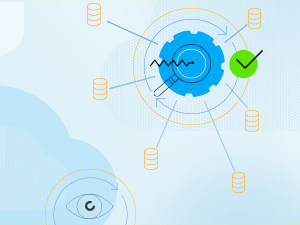HIPAA Compliance & Managed File Transfer: Do You Have a Safety Net?

Security breaches are occurring at an alarming rate as cybercriminals continue to successfully infiltrate the IT infrastructures of organizations across many industries.
As more and more sensitive information is stolen, compliance with regulations is coming under greater scrutiny. All organizations that create, receive, maintain, or transmit protected information need to explore the necessary compliance requirements.
Understanding HIPAA Compliance
For the healthcare industry, all eyes are on HIPAA—the Health Insurance Portability and Accountability Act. The compliance mandates of the regulation have evolved considerably since its initial launch in 1996. It’s thus important for IT professionals who work for organizations that handle healthcare information to know the stipulations of past HIPAA releases and to keep up with future changes so that they know all the security and compliance controls that need to be applied. Systems that are compliant today may not be compliant when the next HIPAA update rolls around.
Initial Compliance Mandates Expand Rapidly
Originally launched to improve the efficiency and effectiveness of the healthcare system, HIPAA applies not only to healthcare providers (identified as Covered Entities), but also any business (identified as Business Associates) and subcontractors that partner with healthcare organizations to process data pertaining to patients. The initial Act required Covered Entities and Business Associates to adopt national standards for electronic healthcare transactions and code sets, unique health identifiers, and security.
Realizing that advances in electronic technology could erode the privacy of health information, Congress also incorporated provisions that mandated the adoption of Federal privacy protections for individually identifiable health information. That led to the first major add-on to HIPAA in 2000—the Privacy Rule.
Modified in August 2002, this rule set national standards for the protection of individually identifiable health information by three types of Covered Entities that conduct electronic health transactions: health plans, healthcare clearinghouses, and health providers. In 2003, the Security Rule went into effect, protecting the confidentiality, integrity, and availability of electronic protected health information.
That was soon followed by the Enforcement Rule, which provides standards for the enforcement of Administrative Simplification Rules, and the final Omnibus rule, which implements a number of provisions of the HITECH Act—to strengthen the privacy and security protections for health information established under HIPAA. This rule also finalized the Breach Notification Rule.
HIPAA Requirements and Potential Fines
At a very basic level, to achieve HIPAA compliance an organization needs to conduct audits and assessments at least once per year. These include identifying and measuring security risks, privacy controls, security standards, and breach response protocols. Every IT asset must be audited as well as each site for the physical security it provides over IT assets.
The audits and assessments must also identify all security deficiencies, and organizations need to create documented remediation plans to address those deficiencies. As with the audits and assessments, remediation plans also need to be updated annually.
Improve HIPAA Compliance Through Training
Organizational IT teams also have to go through annual HIPAA training, with one person being designated as the HIPAA officer for the organization—overseeing compliance, privacy and security. Covered Entities also need to track the HIPAA compliance status of all their Business Associates that handle patient information.
It all adds up to a lot of work so be careful the fully check out what’s required. Those that fail to comply are subject to severe fines and penalties in the event of a breach. HIPAA fines can run as high as $50,000 per violation (or per record), with a maximum penalty of $1.5 million per year for violations of an identical provision. Violations can also carry criminal charges that can result in jail time.
File Transfer Best Practices for HIPAA Compliance
Any organization that handles file transfers containing protected heath information (PHI) needs to closely adhere to the HIPAA Security Rule. In a nutshell, file transfer systems must protect the confidentiality, integrity and availability of PHI.
The Security Rule is separated into three types of safeguards: administrative, physical, and technical. Under these safeguards, organizations can secure data and conduct HIPAA-compliant file transfers by adhering to these best practices:
- Prevent unauthorized access to PHI from unauthorized users.
- Track all user activity on systems containing PHI.
- Establish security protocols to insulate data in motion from unauthorized access.
- Disconnect electronic sessions once file transfers are completed.
- Encrypt any PHI data that is transferred.
- Prove that transferred data has not been altered, compromised, or deleted without authorization.
We encourage you to visit the U.S. Department of Health and Human Services HIPAA website to learn all that you can about HIPAA in general and the Security Rule in particular. It’s also wise to work with information security professionals who have vast experience in designing, deploying and auditing IT systems for HIPAA compliance.
Managed File Transfer—the Ideal Method for HIPAA Compliance
A Managed File Transfer (MFT) solution is the best way to ensure PHI data remains in compliance as files are transferred within your organization and in exchange with your business partners. The leading MFT solutions allow you to consolidate all file-transfer activities into one system to ensure better control and provide security through centralized access controls, file encryption and activity tracking.
In addition to helping comply with regulations such as HIPAA, MFT helps you maintain operational reliability and compliance with your internal SLAs and governance requirements. You can also automate workflows without creating scripts.
This means you can accelerate the rollout of new services and the onboarding of new external data-sharing partners by reducing development time while significantly reducing the likelihood of errors. Another key benefit the leading MFT solutions is the ability to streamline compliance reporting and audit preparation with automated reporting of tasks, workflows and file-transfer activities.
Protect All Your File Transfers
To create a safety net to protect all of your organization’s file transfers, and to make sure they remain in compliance with HIPAA and other regulations, check out MOVEit Managed File Transfer (MFT) from Ipswitch. MOVEit is HIPAA, GDPR and PCI DSS compliant, and the software is available for on-premises deployments and as a service in the cloud. Visit our website for a free trial.

Kevin Conklin
Kevin joined Ipswitch in 2015 and leads the company’s product and content marketing practices. He is widely recognized for his product marketing accomplishments in information technologies. He is a serial startup executive having played instrumental roles in the success of such companies as for Prelert, VKernel, Mazu Networks and Smarts, Inc. and has been instrumental to the success of these IT management technology companies. Kevin is also the co-host of the PICNIC Podcast live show (https://picnic-podcast.com/), sharing experiences and best practices, providing a voice of expertise, and educating IT professionals with the latest technology challenges.
Next:
Comments
Topics
Sitefinity Training and Certification Now Available.
Let our experts teach you how to use Sitefinity's best-in-class features to deliver compelling digital experiences.
Learn MoreMore From Progress
Latest Stories
in Your Inbox
Subscribe to get all the news, info and tutorials you need to build better business apps and sites




